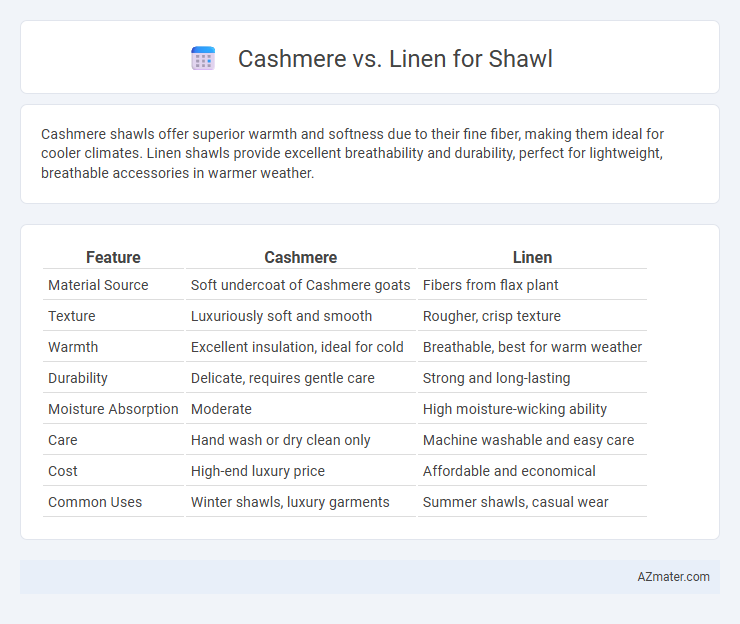Cashmere shawls offer superior warmth and softness due to their fine fiber, making them ideal for cooler climates. Linen shawls provide excellent breathability and durability, perfect for lightweight, breathable accessories in warmer weather.
Table of Comparison
| Feature | Cashmere | Linen |
|---|---|---|
| Material Source | Soft undercoat of Cashmere goats | Fibers from flax plant |
| Texture | Luxuriously soft and smooth | Rougher, crisp texture |
| Warmth | Excellent insulation, ideal for cold | Breathable, best for warm weather |
| Durability | Delicate, requires gentle care | Strong and long-lasting |
| Moisture Absorption | Moderate | High moisture-wicking ability |
| Care | Hand wash or dry clean only | Machine washable and easy care |
| Cost | High-end luxury price | Affordable and economical |
| Common Uses | Winter shawls, luxury garments | Summer shawls, casual wear |
Introduction: Cashmere vs Linen Shawls
Cashmere shawls are prized for their exceptional softness, warmth, and luxurious texture derived from the undercoat of Cashmere goats. Linen shawls offer a lightweight, breathable fabric made from flax fibers, ideal for warmer climates and providing a crisp, natural feel. Choosing between Cashmere and Linen shawls depends on desired warmth, texture, and seasonal use.
Natural Origins: Cashmere and Linen Fibers
Cashmere fibers are derived from the undercoat of Cashmere goats, primarily found in regions like Mongolia and Kashmir, known for their exceptional softness and lightweight warmth. Linen fibers originate from the flax plant, cultivated mainly in Europe, valued for its strength, breathability, and moisture-wicking properties. Both materials embody natural origins that contribute to their unique textures and durability in shawl production.
Texture and Feel: Softness Comparison
Cashmere shawls offer an exceptionally soft and luxurious texture due to their fine, natural fibers, providing a warm yet lightweight feel that is gentle on the skin. Linen shawls have a crisp, breathable texture that is coarser than cashmere but perfect for a cool, airy sensation, ideal for warmer climates. The softness of cashmere surpasses linen, making it the preferred choice for comfort and elegance in shawls.
Warmth and Insulation Properties
Cashmere shawls offer superior warmth and excellent insulation due to their fine, dense fibers that trap heat efficiently, making them ideal for colder climates. Linen shawls, while breathable and lightweight, provide minimal insulation and are better suited for mild or warmer weather where moisture-wicking is important. Choosing between cashmere and linen depends on the desired balance of warmth and breathability for specific environmental conditions.
Breathability and Temperature Regulation
Cashmere offers exceptional warmth and softness, making it ideal for cold weather, but its breathability is moderate due to dense fiber structure. Linen is highly breathable, allowing air to circulate freely, which helps in effective temperature regulation and keeps the wearer cool in warmer climates. For shawls, choosing linen enhances ventilation and moisture-wicking, while cashmere provides superior insulation for cooler environments.
Durability and Longevity
Cashmere shawls offer exceptional softness and warmth but require delicate care due to their fine fibers, making them prone to pilling and wear over time if not properly maintained. Linen shawls, made from flax fibers, boast superior durability and resistance to wear, with increased longevity stemming from their strong, breathable texture that becomes softer with use. Choosing between cashmere and linen depends on balancing the desire for luxurious softness against the need for a robust, long-lasting fabric.
Maintenance and Care Requirements
Cashmere shawls require delicate care, including hand washing with mild detergent or dry cleaning to maintain softness and prevent damage, while avoiding direct sunlight and moth exposure during storage. Linen shawls are more durable and can be machine washed on gentle cycles, but should be air-dried to prevent shrinkage and maintain fabric integrity. Proper maintenance of both materials extends the lifespan of the shawl and preserves their luxurious texture and appearance.
Aesthetic Appeal and Style Versatility
Cashmere shawls offer a luxurious, soft texture and a rich visual appeal that complements both formal and casual outfits, elevating any wardrobe with timeless elegance. Linen shawls provide a lightweight, breathable fabric with a natural, matte finish that suits relaxed, earthy styles and adapts well to warm-weather ensembles. The aesthetic appeal of cashmere lies in its smooth drape and subtle sheen, while linen's versatility stems from its crisp structure and effortless layering potential.
Price and Value Considerations
Cashmere shawls typically command higher prices due to the luxurious softness and warmth derived from fine goat fibers, making them a valuable investment for cold climates and elegant occasions. Linen shawls, crafted from flax fibers, offer a more affordable option with breathable, lightweight qualities ideal for warmer weather and casual use. Comparing cashmere's premium cost against linen's durability and ease of care highlights key value considerations for seasonal versatility and long-term wear.
Choosing the Right Shawl for Your Needs
Cashmere shawls offer unmatched warmth and softness, ideal for cold weather and luxury occasions, while linen shawls provide breathability and durability, making them perfect for warmer climates and casual wear. Consider your climate, desired comfort level, and occasion when choosing between cashmere and linen; cashmere excels in insulation, whereas linen ensures moisture-wicking and lightweight feel. Budget and maintenance preferences also influence selection, with cashmere requiring delicate care and a higher price point compared to easy-to-clean, affordable linen options.

Infographic: Cashmere vs Linen for Shawl
 azmater.com
azmater.com